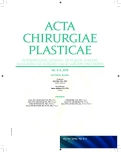A-16 COMPLICATION OF IMMEDIATE TWO STAGE BREAST RECONSTRUCTION AFTER MASTECTOMY
Authors:
I. Justan; O. Coufal
; L. Gabrielová
Authors‘ workplace:
Masaryk Oncology Institute, Department of Surgical Oncology, Brno, Czech Republic
Published in:
ACTA CHIRURGIAE PLASTICAE, 57, 3-4, 2015, pp. 70-71
Category:
Selected abstracts from the 36th national congress of the czech society plastic surgery with international participation
Introduction
Between 2012 and 2015, we performed over 100 mastectomies followed by immediate breast reconstruction in 64 patients, from which in 62 we used two stage reconstruction with implantation of breast tissue expanders covered with tissue pocket. Since the beginning we follow the principles described by J. J. Disa from Memorial Sloan Kettering Cancer Center, New York and published e.g. in Grabb&Smith´s Plastic Surgery. The principle is a complete tissue pocket covering the whole expander. The goal of this presentation is an analysis of a group of patients with regards to complications of this method.
Methods
Within the period from September 2012 to May 2015, we performed totally 99 mastectomies in 62 patients. Most patients (41) underwent the procedure on both sides simultaneously, only 21 patients underwent unilateral procedure (11 on the right side, 10 on the left side). The tissue expander was immediately inserted after mastectomy to a standard tissue pocket. This pocket consisted of major pectoral muscle with anterior sheet of rectus abdominis muscle fascia in 100% supplemented either with anterior serratus muscle including fascia (35 patients), with partially elevated anterior serratus muscle or combination (2 patients) or we used only fascia of serratus anterior muscle (26 patients). In all 62 patients, we used Mentor® tissue expanders, from which 56 were Tall Height expanders and 6 were Medium Height expanders. Median of expander size was 450 ml (range 350 to 750 ml). The classical approach for elevation of muscles was used in 37 patients, transmuscular approach in 24 patients. In 1 patient we used our modified technique.
Results
The most frequent complication in our group of patients is epidermolysis of skin cover, mostly near the mastectomy scar, which occurred in 20 patients (20.2%). All cases were treated conservatively without an effect on subsequent filling. The second most frequent complication was rotation of expanders (6 patients – 6.1%) or rotation of implant (6 patients – 6.1%). Furthermore there was seroma (5 patients – 5.1%). The more serious edge necroses were treated in 4 (4%) cases by aspiration from the expander or excision of necrosis. Due to infection (3 patients – 3%) was needed removal of the expander in 2 cases (2%). So far we did not have to remove an implant due to a complication.
Conclusion
Two stage reconstruction of the breast after therapeutic mastectomy is worldwide well established reconstructive breast technique, which is indicated mainly in patients in whom it is not possible to perform another type of reconstruction, e.g. using own tissue. Percentage of main complications in our file (rotation of expander, rotation of implant, seroma, necrosis, removal) is similar to the percentage at other centers. Failure of the method was reported in 2% of reconstructions.
Support: The work was supported by the project MŠMT – NPU I – LO1413 and MZ ČR – RVO (MOÚ, 00209805).
Labels
Plastic surgery Orthopaedics Burns medicine TraumatologyArticle was published in
Acta chirurgiae plasticae

2015 Issue 3-4
- Metamizole vs. Tramadol in Postoperative Analgesia
- Metamizole at a Glance and in Practice – Effective Non-Opioid Analgesic for All Ages
- Current Insights into the Antispasmodic and Analgesic Effects of Metamizole on the Gastrointestinal Tract
- Spasmolytic Effect of Metamizole
- Obstacle Called Vasospasm: Which Solution Is Most Effective in Microsurgery and How to Pharmacologically Assist It?
Most read in this issue
- 36th NATIONAL CONGRESS OF THE CZECH SOCIETY OF PLASTIC SURGERY WITH INTERNATIONAL PARTICIPATION
- Dorsoradial forearm flap with silicone bone spacer in reconstruction of A combined THUMB injury – case report
-
ZORA JANŽEKOVIČ
(September 30, 1918 – March 17, 2015) - Editorial
